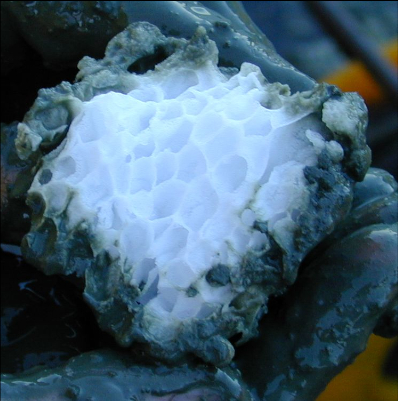Ice that burns?! Sounds like a fantasy novel but actually methane hydrate seems to be a promising energy source for the future. Since coal and oil are finite resources, humanity is required to find access to new energy sources in order to maintain the modern standard of living. On the long term renewable energy sources are undoubtedly the best solution, but until the whole world is equipped with this technology, the machinery as well as storage facilities for renewable energies humanity is still dependent on conventional energy sources. Methane hydrate could be a great option to fill this gap between conventional energy sources and renewable energy sources as it can be used in a similar way like natural gas with existing machinery while emitting significantly less carbon dioxide. This article attempts to give a brief overview about its characteristics, the production technology as well as possible dangers linked to this energy source.

Typically methane hydrate can be found in the continental shelf or in the continental rise where it is enclosed in sediment layers. In the upper layers of the ocean, where life flourishes, large amounts of dead organic material are being accumulated. This biomass sinks downwards where archaebacteria dismantle it to methane. Furthermore the methane can originate from thermal decomposition of complex organic material. In depths of at least 200 metres this methane now forms the hydrate due to the high pressure in combination with low temperatures of 2 to 4 degrees. The hydrate occupies small cracks and pores in sediment and stone which is why it contributes to the static stability of the continental shelf. Even tough it kind of resembles regular ice, methane hydrate is composed of methane molecules that are captured in cages of water molecules. Methane is a flammable gas which is why the hydrate can be set on fire once it has been transported to the surface.
In order to realise the production of methane from methane hydrate several obstacles need to be overcome. First of all the hydrate is only stable in the depths of the ocean and it is not viable to transport the whole hydrate to the surface. That’s why the methane needs to be released at the bottom of the sea by decomposing the hydrate before it can be transported to the surface through pipelines. Researchers have come to the conclusion that alternating between inserting hot water into the reservoir and releasing the pressure on the hydrate is the most efficient way to do so. However many scientists are concerned that methane production could destabilise the continental shelf since a lot of hollow spaces would be created. Eventually this could cause a collapse of the continental shelf which would have severe effects on the marine ecosystem and might even have the potential to cause a tsunami.
There is for example the possibility of filling the cavities left behind by the methane hydrate with carbon dioxide in order to maintain the stability of the shelf. However it is not yet clear if that could be a solution for methane hydrate production on a large scale. Until today there is no mass production of methane hydrate but China and Japan carried out tests in the Southern Chinese Sea and reported the production of 300.000 m3 methane.
Sources:
https://de.wikipedia.org/wiki/Methanhydrat
https://www.welt.de/wissenschaft/article164875577/Brennendes-Eis-soll-die-Energie-der-Menschheit-revolutionieren.html
